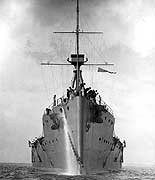 A poster on the UMGF asked why Dreadnoughts were called Dreadnoughts.
A poster on the UMGF asked why Dreadnoughts were called Dreadnoughts.I replied that they were named after a class of battleship, but then another poster corrected me and said it was named after a specific ship.
This prompted my reply:
Actually, not a minor detail! (as I discovered after reading your post!)
The Dreadnought was a ship, but it was also a class of ship. Just as the Forestall is both a specific aircraft carrier, and a class of aircraft carrier.
Martin's own history mentions the class yet I found a listing on About.com that mentioned the battleship.
Most of the Internet listings seem to use the class story, though they are mostly borrowed from Martin's article.
Growing up (prior to knowing anything about Martin's) I was familiar with the term being used for a large battleship, but had never heard of the specific ship (until tonight!)
Here we get into a generational thing; I wonder if anyone would know whether CF Martin, back in 1916, was aware of the specific ship, or had just heard of these large ships, called dreadnoughts?
A little sleuthing; if you read this history of naval warfare it appears that the original ship Dreadnought was the first of a new breed of ships (it was launched in 1906), and that at the time, there was a race to build bigger and bigger ships. Dreadnought became the term everyone used for these very large ships, and by 1914, the original ship was outmoded.
It's clear that the ship Dreadnought resulted in the name being applied to all large battleships, but I think it's more than likely that the Dreadnought guitar shape was named after the class, rather than the specific ship.
You're probably wondering if this is just a distinction without a difference, but actually, I think it's a minor, but interesting issue (though it surely will not effect the tone of your D-28.)
I will admit that I'm taking a wild guess here, but I base this on the following:
1) The original ship Dreadnought was a British ship. It's unclear to me that this ship would have been widely reported or hailed in the US.
2) The term Dreadnought was used for all large battleships, and there was a race to build bigger and bigger ones. This was probably widely reported in the US
3) By 1914, the ship Dreadnought had already been superseded by even larger ships.
4) Why would CF Martin name it after a British ship (the US wasn't then involved in World War I) rather than an American one? I could understand it if the ship was legendary, but other than it being the first really big battleship, I don't think it was legendary at all, and by 1916 it was no longer the largest battleship.
But if the US Navy was building large 'dreadnoughts,' and they were frequently referred to by this term, then it would seem to make sense that the public would start using the term for other things and that Martin would then adopt the term as well.
I admit that there's an assumption here that the original ship was not widely known and hailed in America.
Counter to my argument, it's entirely plausible that when the Dreadnought was launched in 1906, it was so large (like the Titanic) and was covered so widely in the press, such that people immediately started using the term in everyday speech ("it's the Dreadnought of bed pans") and that using the description 'Dreadnought of' could have been rooted in speech for a long time and Martin just borrowed this phrase that was already widely used. I'm a little doubtful of this, as again, I don't think the ship itself was widely known.
I think we need to find a historian....
Sorry for the nit-picking, but I actually think it's an interesting story.
On reading this post, the original poster accused me of being neurotic! :(

No comments:
Post a Comment